Aputure Light Storm LS 1/2 W
TL;DR - The Aputure LS 1/2 W is a compact but high quality LED light that is uniquely built with a super wide 120 degree spread. It’s a wonderful light to add to an established light kit, to use as a fill and bounce light, and especially for lighting green screens.
Start-up videographers putting together their first gear kit have an extremely difficult challenge: they have to get the most bang for their buck from their initial purchases, before their business grows and allows them to buy more gear.
We’ve outlined this cycle in our corporate video production guide. In essence, you buy some gear, produce some work, which allows you to buy more and better gear, which enables you to produce more and better work (and more efficiently), which allows you to do more work at higher prices, leading to more/better gear, and so on.
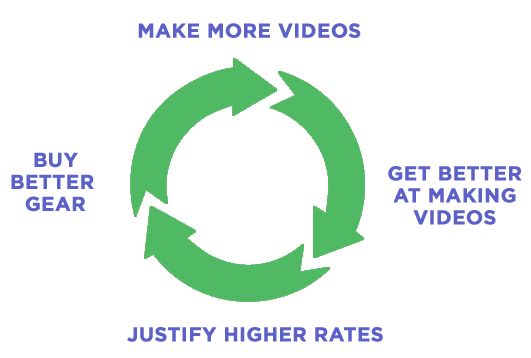
In the lighting department, the first decision often means a pain staking search for the one perfect light. This light would give you the most flexibility, brightness, portability, and ROI than any other light out there. This is the God light. When you find it, you imagine you will be good for years.
And when you do settle on that perfect light, you feel damn good. You may even buy two or three to make a kit. And then you sit back and sigh a sigh of relief. You did it.

In reality, as soon as your business picks up, you’ll find that your one light (or one light kit) isn’t enough. You start to walk into different scenarios than just the one you planned for initially. And each situation requires different lighting solutions, whether that means something with more punch, or is more portable for field use, or is more shapeable, or is bicolor, or less power hungry, or have a different quality to them, and so on.
If this weren’t the case, the lighting industry would dry up. We’d all be good with our current lighting kit, and we wouldn’t be on the market for new lights for years. After all, LEDs are supposed to last tens of thousands of hours.

But instead, the lighting industry is alive and well with innovation, development, and a line of video producers ready to buy more lights to add to their arsenal.
If you haven’t already, we recommend you watch “The Art and Skills of Quality Interviews” by Nino Giannotti. Nino specializes in producing high quality broadcast interviews, so expertly lighting the subject and background is how he makes a living.
In the tutorial, you’ll see that even after 50 years of production experience, walking into every lighting situation is a different challenge, and you must be prepared with a wide assortment of lights (and grip gear) to succesfully tackle even something as deceptively simple as a single camera interview.
Aputure Light Storm LS 1/2 Specs
Aputure has rapidly become known as a company that builds affordable, but well-built lights. They have an assortment of small on-camera and accessory lights, their flagship LED panels, and their new foray into COB fresnels. We’ve written about both the Amaran and Light Storm panel lights, as well as the LS 120D LED Fresnel light.
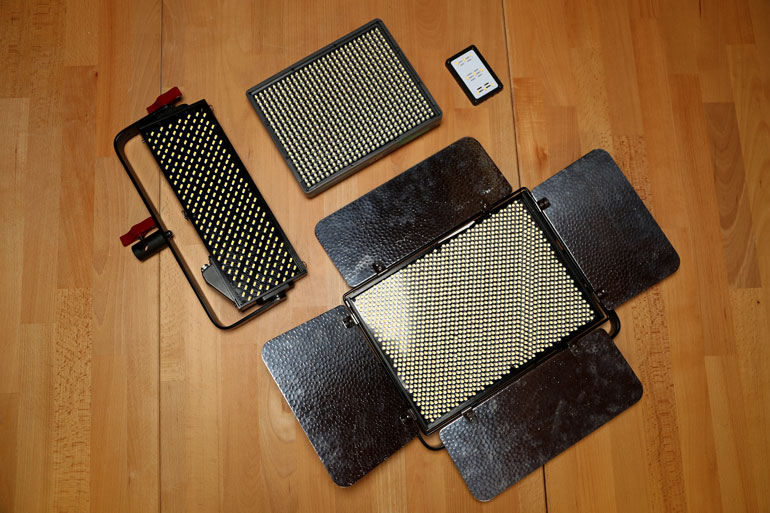
The Light Storm LS 1/2 W is a great addition to their lighting products, and it deserves a place in many established light kits.
The LS 1/2W has 264 SMD LEDs, daylight rated, with a CRI of 98, and a super wide beam angle of 120 degrees. It’s made out of aluminum alloy, and fits right at home with the its siblings the Light Storm LS1S and Light Storm LS1C.
The LS 1/2 is appropriately named because it’s about half the size of the other Light Storm panels. It features the same style of controller box, which is separate from the panel itself. The controller box comes in either a V-mount or Anton Bauer battery mount. It also has a separate AC adapter for mains power.
For the most part, the controller box is nearly identical to the other Light Storm panels, except that the AC power is smaller and more portable, since the power draw is much less than the larger panels.

We really like how Aputure has separated the controller from the back of the light, which you find on many lights these days. It means you can set the light high on very lightweight light stands (we use the Manfrotto Nano 5001B exclusively for all our lights), and then hang the controller and battery low on the light stand as a counterweight.
Then, when you need to adjust output or turn the light on/off, you don’t have to move the light down or reach up high to its panel. The separate controller is very convenient. The downside is that there are a few pieces you need to keep track of and connect together, anytime you setup the light, including the Lemo cable from the LS 1/2 to the controller, the XLR cable from the controller to the AC brick, and then the power cable from the AC to the wall output.

Like most Aputure lights, the LS 1/2 can be controlled via its universal Aputure remote. Seriously, this is a great reason to have a few Aputure lights in your kit. We can (and have) setup a scene with a variety of Aputure lights, with brightness and color adjustments all from one remote.
This feature is especially useful for single camera operators, where you can place your subject where you want them, and then remotely control the lights from behind the camera, dialing in the exact exposure and look that you want without having to run back and forth to each light.

The LS 1/2 is daylight balanced at 5500K, so if you need tungsten you’ll have to gel it. Conveniently, it has easy to use gel clips at the top of the light. Aputure also provides a few diffusion papers in the box, which can be attached to the gel clips. They reduce the output by 85%, but they widen the beam angle to a whopping 180 degrees.
LS 1/2 Output
Compared to the other Light Storms, the LS 1/2 has a deceptively low light output. With only 264 LEDs, it outputs 1100 lux at one meter. But keep in mind, that’s at a 120 degree angle. It’s important to look at beam angle when researching any light specs. A super narrow beam angle will naturally have a much higher output read.

As a comparison, the Amaran AL-HR672W has 672 LEDs at a 75 degree beam angle, and outputs 2080 lux at one meter. The Light Storm LS 1C (at a daylight setting) uses 768 LEDs at a 45 degree beam angle, for approximately 5000 lux at 1 meter. And the Light Storm LS 1S has 1536 LEDs at a very narrow 25 degree beam angle, producing a whopping 10,500 lux at one meter.
So if you’re just looking at size and number of LEDs, you are only seeing a portion of the light metrics that determine a particular light’s utility. There are other differences of course, including total size and weight, durability, mounts, and other factors that help you decide on which lights you would want for which situations.
LS 1/2 Use Cases
For having such a wide beam angle in a small (but very durable) package, we think this light naturally fits into established kits. You would not choose the LS 1/2 as your first and only light.

Remember, when looking for a perfect God light that does everything for you, you want to err on the bright and narrow side. You can diffuse a bright light with a narrow beam, and you can control it with barn doors or a fresnel lens (if you’re using a fresnel light). But it’s impossible to take a soft wide light and model it into a narrow, bright, hard light.
For interviews, the LS 1/2 is a great light to use to light an overall room or a backdrop, where you can kill the room’s practical overheads and use your LS 1/2 to get the perfect amount of bounce and brightness.
You could also use the LS 1/2 as your fill light. If your main key light is shooting through a diffusion screen, you don’t necessarily have to add diffusion to your fill, as long as it’s placed at the subject’s eye level. That way it won’t be creating harsh shadows, negating the soft diffused effect of your key.
If you’re planning to conduct outside interviews, you would want to look at other lights for your bright key, and potentially a bounce board as your fill. The LS 1/2 is not bright enough to combat outdoor light. For us, we intentionally shoot interviews indoors 99% of the time, because 1) we can better control the light, and 2) we avoid the thousands of distracting sounds outdoors, like airplanes, cars, people, and the inevitable lawn mower and leaf blower that turns on the moment you start rolling.
Aputure Light Storm LS 1/2 for Green Screen
The green screen is where the Aputure LS 1/2 W really shines. In fact, even if you only use it to light a green screen, and you shoot green screen for only a small portion of your work, the LS 1/2 is a worthwhile light to have in your kit.
The LS 1/2 wide beam angle solves a lot of the issues we all have with lighting a green screen. You want a wide, flat spread across the screen, but the lights need to be placed relatively close to the screen, behind the subject, and off to the side, out of the frame.
In reality, you really need a pair of LS 1/2 to light a green screen, one for each side. But in the following comparison, we placed just one light to the side of our Impact 5x7 collapsible green screen, and we rotated a variety of lights we had which are similar in cost, size, and output, but had different beam angles.
We didn’t move the camera, light stand, or adjust the camera’s exposure while rotating the lights. But that said, we do not conduct “scientific” light tests, so please don’t treat this as such. The lights were placed roughly one meter away from the screen, but we didn’t measure it exactly, so there.
Also please note these are ungraded pictures straight from the Canon 1DX mkII, in a Neutral photo setting. When color corrected and adjusted for contrast, the light hot spots would be even more noticeable.
Aputure LS 1/2
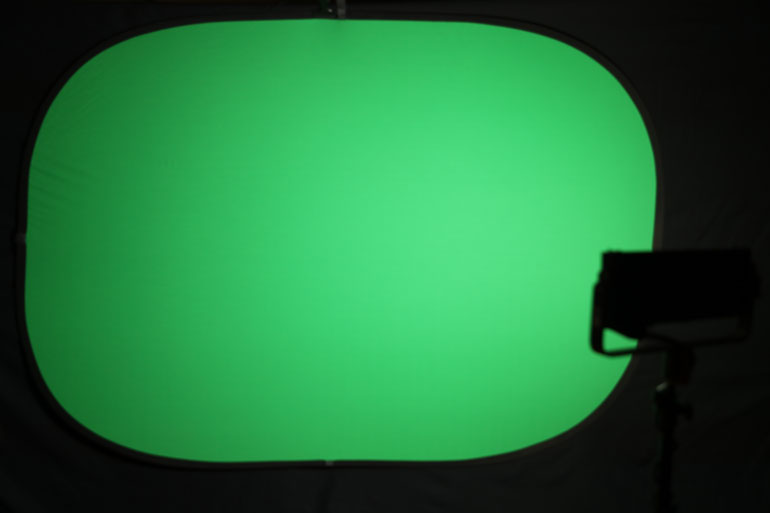
The LS 1/2 has a really nice wide spread on the green screen, even from just one side. This is at max brightness. If you had two, one on each side, the green screen would be very evenly lit.
Coreswx TorchLED Bolt

The CoreSWX TorchLED Bolt is a very powerful light in a tiny package. But the reason it has high output is because it has a very narrow beam angle (roughly 30 degrees, according to specs). This is at max brightness, with daylight bulbs on only. It's rated at 2000 lux at 1 meter.
Aputure Amaran 672W

The Aputure Amaran 672W is our favorite Amaran light, because it's so damn portable and convenient. We always bring a couple along, no matter if we intend to use them or not. It has 672 daylight LEDs, outputting 2080 lux at 1 meter.
Remember, we didn't change the camera exposure settings in between the lights, so if you compare the Amaran 672W to the LS 1/2 output, they're pretty similar, despite the Amaran having twice the LEDs and twice the lux rating at 1 meter.
This is because the Amaran has a 75 degree beam angle, compared to the LS 1/2 120 degree angle. While the Amaran is has a super high ROI - it offers a lot of value for the cost - you can see it creates a bright spot in the green screen, while the LS 1/2 does not.
Dracast LED500
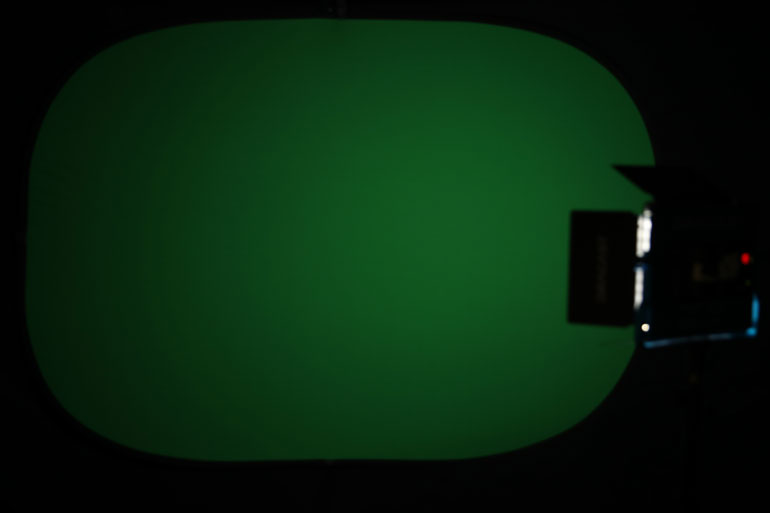
We bought two of the Dracast LED500 lights during a flash Black Friday sale. They were like $100, so on a whim we bought a couple. While the housing and barn doors are nice, the output is insanely low.
The specs say it outputs 5500 lux at 1 meter, with a beam angle of 45 degrees. Since ours is bi-color, we would cut the output in half in this case, since we're shooting daylight only. Still, does that look like 2250 lux? Hmm. Compare this to the Amaran 672W above, which should have roughly the same output.
Maybe the diffusion screen cuts the output by a lot. Or maybe it's the low 29W power draw. Who knows. Moving on.
Falcon Eyes RX-18T Flex Light
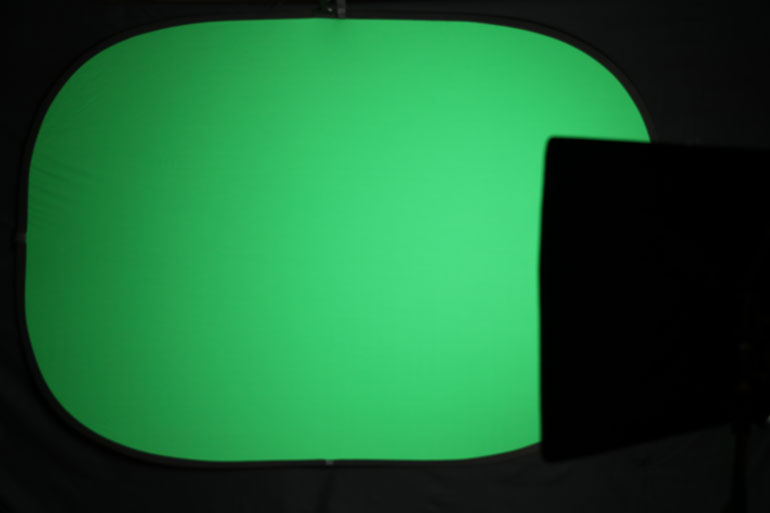
We bought and reviewed a few of these flex light knockoffs recently - check out our flex light review. This is the Falcon Eyes RX-18T, the daylight-only version. It's an 18x24" flexible mat, featuring 504 LEDs, with a claimed output of 2500 lux at 1 meter.
The specs are difficult to understand, but they claim the LEDs have a very wide beam angle of 10-360 degrees, which doesn’t really make sense, but oh well. It's wide, and does a great job of shooting the green screen evenly without hot spots.
However, the size of this light is several times bigger than any of the other lights here. Naturally, a wider light source will have a wider spread. We really like this light for interviews, but it would be a little challenging for green screen work, since you'd have to move them way off to the side to get them out of the frame.
Cineroid L10-VCE

And just for fun, we threw in the little Cineroid L10-VCE. It's about the size of a pack of cards, powered by a Sony NP battery, and can do 400 lux at 1 meter. However, it's bicolor, so it's most likely less with daylight only bulbs.
We wanted to try this light on a green screen, because like the LS 1/2, it has a beam angle of 120 degrees. However, it has only 96 LEDs, and half are daylight, so you're looking at a fraction of the output as the LS 1/2.
You can't really compare this little light to the LS 1/2 W, but you can compare it to the Dracast LED500. Pretty interesting how close they are in output, even though the Cineroid is like 1/20th the size and weight.
It would be interesting to compare this fairly old Cineroid to the brand new Aputure MX light, which has 128 LEDs. Another time, another review.
Conclusion
As we began this review, we come back to the main point here, that it's essential for videographers, documentary filmmakers, and corporate video producers to carry a variety of lights with them. Every situation is different, even for the boring single camera, single subject interview. Every room, background, and subject presents a different challenge.
The Aputure LS 1/2 W is a valuable addition to any light kit, whether it's for interviews or narrative work. But as we've seen here, it's especially useful for lighting green screens. Having a flat, even light is essential for a green or blue screen. The LS 1/2 is almost made for this specific purpose.
And if you do plan on using the LS 1/2 W for green screen, you'll want two of them, one for each side.
Questions? Comments? Shoot us an email. Thanks for reading, and happy shooting!
Aputure Light Storm LS 1/2 W
- 264 LEDs, at 120 degree beam angle, for an output of 1100 lux at 1 meter.
- Daylight balanced with a CRE of 98.
- Intended to be used as a fill for wall bounce, green screens, backdrops, or anywhere you need a lot of light spread.
- Durable construction and features the same controller box and remote as the other Light Storms.


